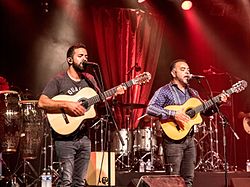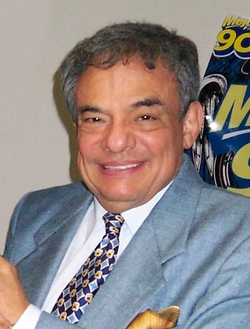Overview
The 1980s saw the major record labels such as RCA/Ariola, CBS, and EMI form their own Latin music divisions. [1] By 1985, Billboard noted that the Latin music industry saw increase in awareness from major corporations such as Coca-Cola promoting Julio Iglesias and Pepsi advertising Menudo. [2]
Latin pop
The romantic balada, which gained popularity in the 1970s, continued to dominate the Latin music charts in the 1980s. Veteran balladeers who continued to be popular in this decade include Julio Iglesias, José José, Roberto Carlos, and Juan Gabriel. [4] The Latin balada is characterized by its bolero origin by fusing music from the United States with pop, R&B, and rock. [5] The 1980s was a golden era for the Venezuelan entertainment industry as popular telenovelas from the country also led to several actors to become successful singers such as Carlos Mata and Guillermo Dávila. Theme songs from telenovelas also became popular on radio airwaves in Venezuela. [6] Female balada singers that became topped the Latin music charts includes Ana Gabriel, Daniela Romo, Rocío Dúrcal, Gloria Estefan, and Marisela. Notably, several baladas were Spanish-language covers of songs originally performed in Italian. Notable Spanish-language covers of Italian songs include "La maldita primavera" by Yuri, "Toda la Vida" by Emmanuel and Franco, "Yo No Te Pido la Luna" by Daniela Romo, and "Tan Enamorados" by Ricardo Montaner. [7]
Aside from the baladas, several Latin pop artists and bands performed variety of Spanish-language pop and dance music targeted to the younger audience. These include Yuri, Marisela, Mecano, Miguel Bosé, Timbiriche, Menudo, and Flans. [8] "Que Te Pasa" became the longest-running chart of the 1980s, spending 16 weeks on top of the Billboard Hot Latin Tracks chart. [9] Juan Gabriel and Rocío Dúrcal collaborated with Chuck Anderson to incorporate mariachi arrangements on their ballads. [2] Child pop singers such as Pablito Ruiz, Luis Miguel, Pedrito Fernández, and Lucerito had a prepubescent following. [10] The Miami Sound Machine, whose vocals were led by Gloria Estefan, gained international fame in 1985 with their crossover hit song "Conga". The song blends both pop music and Latin music from the Caribbean. [11]
Regional Mexican
In the 1980s, the regional music scene in both Mexico and the Mexican American community in the United States was dominated by grupera . This style of Mexican music combines cumbia, norteño, and rock music. [5] The lyrics are rooted with romantic themes including heartbroken songs. Several notable grupera ensembles include Los Caminantes, Los Yonic's, Los Bukis, and Los Temerarios. [12] Norteño band Los Tigres del Norte continued their success from the 1970s with their corridos involving social commentary such as "Jaula de oro" ("The Golden Cage") which tells of a Mexican man who crosses the Mexico-United States border illegally and raises a family in the United States who denies their Mexican heritage while the man longs to return to his country. [13] Its parent album reached number one on the Regional Mexican charts in the United States. Similarly, Mexican singer-songwriter Joan Sebastian incorporated sounds of rancheras and ballads on his songs and was dubbed "El Rey del Jaripeo" ("The King of Mexican Rodeo"). [14]
Tejano music was also popular to the Mexican Americans living in the United States mainly in Texas. Its style is characterized by its influences from polka, cumbia, bolero, and ranchera as well as pop, rap, country music and reggae. [15] Tejano bands such as Mazz, La Mafia, and Little Joe and La Familia pushed Tejano's popularity beyond the United States. [16] Ranchera Vicente Fernández still remain relevant in the 1980s. His album, Por Tu Maldito Amor (1989), became the longest running number one Regional Mexican album of the decade in the United States with 21 weeks consecutive weeks at this position. American singer Linda Ronstadt, who is of Mexican descent, released Canciones de Mi Padre , a collection of songs that her father would sing. [17] The album was certified double platinum by the RIAA for shipping over two million copies in the United States.
Tropical/salsa
The New York salsa, which was popularized Fania Records in the 1970s, saw a major decline in the scene. Merengue music from the Dominican Republic became favored by Latinos living in New York City. [18] Wilfrido Vargas was credited for bringing merengue attention to the younger audience. Merengue music also became popular even in Puerto Rico. [19] Another factor to merengue's popularity in the dance clubs was that it was easier to dance to compared to salsa. [20] Milly Quezada, lead vocals of the group Milly y los Vecinos, became the first notable female merengue singer. The group was formed by her husband Rafael Vasquez, who was also her manager. [21] Other notable merengue acts in the 1980s include Bonny Cepeda, Fernando Villalona, Juan Luis Guerra & 4.40 and Los Hijos del Rey. Vargas also formed the first all-female band Las Chicas del Can. [22] Juan Luis Guerra performed not only love songs, but also social commentary about the poverty in [23] the Dominican Republic and those living abroad such as "Visa Para un Sueño" ("Visa For a Dream") and "Ojala Que Llueva Café" ("I Hope It Rains Coffee").
Although New York salsa faded in popularity, another form of salsa music gained attention in its place. This form of salsa, which was slower-placed and more focused on its romantic lyrics, was known as salsa romántica . [24] The salsa romántica movement helped salsa continued to be relevant in spite of the rise of merengue music as well as moving away from lyrics dealing with social class. [25] Salsa romántica was characterized by its influence by the aforementioned romantic ballads and more pop-leaning sounds. [26] In fact, several famous songs done by salsa romántica singers were covers of songs originally sung by balada musicians. [27] "Lluvia", a song first composed by Luis Ángel, was covered by Eddie Santiago and became on the highest-peaking salsa romántica on the Hot Latin Tracks at number four. A sub-style of salsa romántica also included erotic lyrics and became known as salsa erotica. "Ven Devórame Otra Vez" by Lalo Rodríguez, a notable salsa erotica song, became a top ten hit on the Hot Latin Tracks chart. [28] Other famous salsa romantica singers include Frankie Ruiz, Luis Enrique, Willie Gonzalez, David Pabón, and José Alberto "El Canario". [29] In the early 1980s, Cuban musician and bandleader Roberto Torres had a major hit with his cover version of "Caballo Viejo". The song was performed as a charanga vallenata style, a combination of the Cuban charanga and the Colombian vallenato music. [30] It was later inducted into the Latin Grammy Hall of Fame in 2007.
Rock en español

The Rock en Español movement began around the 1980s. Until the mid-80s the rock scene of most Spanish American countries was not connected, and it was rare for a rock band to gain acclaim and popularity outside its home country. Argentina, which had the largest national rock scene and music industry, became the birthplace of several influential rock acts. Soda Stereo from Buenos Aires is often acclaimed as the most influential rock band of the 1980s alongside the solo careers of Charly García, Luis Alberto Spinetta and the new star Fito Páez from Rosario. Soda Stereo was among the first bands to successfully tour across most of Latin America. Argentina developed also during the 80s a ska rock and punk rock scene. The punk movement, which was pioneered by Los Violadores, led to the rise of the Buenos Aires Hardcore around 1990. Soda Stereo released Signos in 1986 which helped pop rock en español music reach to an audience beyond Argentina. [32] In Chile, which was ruled by a military dictatorship all over the 80s, Nueva canción protest songs from the 60s and 70s maintained their popularity despite severe censorship. The progressive/folk-rock band Los Jaivas made a Latin American trademark album with Alturas de Macchu Picchu [sic] based on Pablo Neruda's homonymous poem. The rock band Los Prisioneros were successful in combining the protest song atmosphere of the 80s with newer trends in rock including punk, ska, new wave and techno. In the late 1980s, new bands such as Los Tres and La Ley would start to set the trends for the next decade. In Mexico, the Rock music scene at the time first saw a heavy lack of opportunity as musical acts could not make a solid living from playing alone. Other key factors were that of economic and political instability. Many consider this decade as the lost decade. The government would not allow racy-themed content on television and airwaves, music festivals were not allowed. The music that dominated Mexico and much of Latin America during this era was mostly teen-flavored acts like Menudo, Timbiriche, Flans and others. Rock acts could not land any recording deals because record label executives were much more interested in selling listeners a colourful, hip, and trendy image to the general public ranging from youngsters to middle-aged adults.
Folk/traditional

Flamenco saw a resurgence in popularity thanks to the Gipsy Kings as well as Ketama and Pata Negra. [33]
Brazilian/Portuguese
The lambada dance crazy took over the international market thanks to Kaoma's song of the same name. [34]





